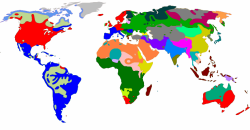Finite and non-finite verb forms

 |
Definitions |
The first thing to define is the term verb. In
what follows, verb generally means
verb phrase.
A verb phrase may be:
- a single word
- as in, e.g.,:
I went to London - a head verb with an auxiliary verb or verbs before it
- as in, e.g.,:
I could have gone to London. - a verb or verb phrase modified by an adverbial
- The adverbial can be an adverb, a noun phrase, a
prepositional phrase or another clause,
as in, e.g.,:
I eventually managed it (adverb pre-modifier)
I have finished this morning (noun phrase post-modifier)
I studied at university in the 60s (prepositional phrases post-modifiers)
I was happier when I worked alone (finite clause post-modifier)
This is not an analysis universally accepted. In some analyses, a verb phrase can only consist of verb forms, whether finite or not. For teaching purposes, because adverbials are so often embedded, it makes some sense to treat the whole item as a single unit.
 |
What the difference between finite and non-finite verb phrases? |
- Finite verbs
- are those which are clearly linked to definable subject and exist either in the present or past tenses. They show tense (for example, by changing the ending or the central vowel) and person (for example, by adding an -s for the 3rd person singular). They can also stand alone and retain their meaning.
- Non-finite verbs
- are not specifically tied to a
subject and do not show tense or person. They can be:
adjectives:
It's a smoking gun
The window's broken
nouns:
I like playing cards in the evening
I hate waiting for buses
infinitives, with and without to:
I came to help
I want to complain
She must help us
For example, the following contain finite and non-finite verb phrases, some modified, some not.
As a short exercise, comment on the verb phrases in the following,
deciding if they are finite or non-finite.
Then click on the
![]() to reveal some comments.
to reveal some comments.
| She
has stolen the money |
This is a finite clause identifiable from the
inflected form of the verb. It contains the
non-finite -en form, stolen.
|
| It’s tidy |
This is a finite clause with an inflected form of
the verb be.
|
|
Smoking is banned here |
This is a non-finite verb operating as a noun.
|
| I'm
smoking too much |
This is the same form of the verb but in a finite verb
phrase with an inflected form of the verb
be. It contains the non-finite
smoking.
|
| It
made me sick |
A finite verb phrase identifiable by the inflected past
form of the verb make.
|
| You
must go now |
A finite modal auxiliary verb with the non-finite bare infinitive.
|
In the third example, there's a finite form in the passive (is banned) and in the last example, there's a non-finite form: go (that's what the term infinitive implies, of course).
Confusion 1
Some confusion is caused in this area by the fact that verbs in
English do not show very many inflexions. A verb may look the
same but be performing different grammatical functions. In,
e.g.
I am playing
we have
a finite verb phrase (with the non-finite -ing participle) but in
I enjoy
playing
we have a non-finite use of the verb play and a
finite use of the verb enjoy which, in English, is not
marked for tense or person.
Equally, in
The game is played
here
we have a passive finite verb phrase with the marked form of
the verb be and the non-finite -en participle and in
A much
played game
we have a
non-finite use of played as an adjective modified by the
adverbial much.
Confusion 2
It is possible to describe individual verbs (rather than verb phrases) in the same terms. For example, the verb playing in I am playing is often described as a non-finite form (because it carries no marker for tense and person). However, in combination with the verb be, as in He is playing, the form is part of a finite verb phrase. We need to be careful with our terms and distinguish between a finite or non-finite clause and a finite or non-finite verb form.
Confusion 3
The -ing form and the -ed forms are both non-finite and often called present and past participles respectively. This is slightly misleading insofar as:
- Regular verbs take -d or -ed depending on
their morphology in both the past tense and the perfect forms so
it becomes impossible simply by looking at the verb to say
whether, e.g., played is the finite past tense of
play or the non-finite past participle in, e.g., They
have played.
The same confusion can arise with irregular verbs as many, such as catch, teach, read etc. have the same form for both past tenses and non-finite participles.
For this reason, many analyses distinguish them by calling the past tense form the -ed form and the past participle form the -en form. That is the system used above. - The -en form (or past participle) is not confined
to past tense structures. It occurs for example, in
She will be invited
where it forms part of future passive form and
She is having her house redecorated
where it forms part of a present-tense causative structure.
Calling it the past participle may lead learners to conclude that it can only be used in past-tense structures. - The so-called present participle or -ing form
exhibits similar problems because it can appear in non-present
tense forms such as
She had been running to catch the bus
or
We will be spending our holidays in France next year
Again, calling it the present participle can mislead. - The -ing non-finite form has multiple functions.
It can, for example,
- form a gerund in:
She dislikes swimming - form part of a progressive tense form in
She is swimming - form part of an iterative (repeated) tense form in:
She was singing in the choir during her teenage years - form part of a continuous tense form as in
She was hoping for a pay rise
- form a gerund in:
- The -ing form is often said to be either a
participle or a gerund but that, too, leads to confusion.
The form can, in fact, occupy an intermediate position between a
gerund proper (i.e., a verbal noun) and a participle (i.e., part
of a finite clause). In, for example:
The buildings were damaged
the noun buildings has been derived from the verb build but functions only as a noun (taking a plural form and not allowing an object as the verb does). Other derived forms work similarly, such as booking, carving, christening, clipping, covering, crossing, drawing, failing, flavouring, heading, meeting, mooring, offering, peeling, rambling, ruling, saving, setting, shaving, sighting, swelling, turning, warning etc. which can all be made plural and rarely take objects. Whether these should be described as gerunds or nouns is not clear.
However, in
Playing the bagpipes is difficult
the word playing is slightly more verb-like insofar as it cannot take a plural (as countable nouns do) but may be treated as a mass noun although it clearly takes an object (the bagpipes) which nouns cannot do.
It may also appear with a possessive determiner as in:
His playing was awful
where it is noun-like insofar as it forms the subject of the copular verb (was) with the complement attribute, awful. Compare, for example:
His music was awful
which is parallel but clearly has a noun as the subject.
The form can, of course be fully verb-like in, e.g.:
He was playing the bagpipes
when it forms part of a transitive verb phrase.
In between, we encounter some less obvious cases of noun-like and verb-like behaviours mixed and where the line is drawn is difficult to see. For example, in:
I heard him playing the bagpipes
the reference is clearly to a progressive event (i.e., a finite tense form proper) and the -ing form takes an object. It is somewhere in between and could be classified as a gerund or a participle.
 |
Verbs of perception |
These verbs, see, hear, notice, observe, smell, sense, watch,
feel work slightly differently with non-finite forms.
The key is to whether reference is to the whole action or a part of
it, usually. For example:
I saw him drink the beer
implies that I saw the whole action, whereas:
I saw him drinking the beer
implies that I only saw a part of the action which started before
and finished after my observation.
Equally, there is a difference between:
I heard her sing at the concert
and
I heard her singing upstairs
in which the first implies that I watched the whole performance and
the second that I hear only part of her singing.
Compare, too:
I saw him sit down vs. I saw him sitting in
the restaurant
I watched her repair the car vs. I watched her repairing the
car
I noticed him talking to the manager vs. I noticed him talk
to the manager
I felt the dog touch me vs. I felt the dog touching me
I smelt the toast burn vs. I smelt the toast burning
and so on.
The difference stems from the sense of a progressive or background
aspect with -ing forms of verbs in English and completed
action with bare infinitives.
 |
Finite verb forms |
Finite verbs in English are sometimes identifiable by the changes
to the verb form. Figure out which of the following English
can show by changing the verb form and then click on the
![]() to reveal some comments.
to reveal some comments.
| Gender |
English has no way to show this either in the singular
or the plural. In some languages, the verb form
will change depending on the gender of the subject (or
the speaker)
|
| Person |
The -s inflexion in the present simple of a
verb indicates the third person singular. This is
the only person inflexion on regular verbs in English.
|
| Number |
The verb be distinguishes plural from singular
(am vs. are, is vs. are)
but the system is incomplete and most verbs only use the
third-person -s to note singular vs. plural (he/she/it
goes vs. they go).
|
| Tense |
This is indicated for most verbs by a change of form or
the addition of a suffix (smoke-smoked, come-came etc.).
Some common verbs, such as put and set,
do not even show this change for tense.
|
| Aspect |
English uses auxiliaries to indicate aspect (the verb
be for the progressive [she is arriving now]
and the verb have
for the perfect [she has arrived]).
|
| Mood |
English only omits subjects in the imperative (Go
home!), sometimes uses an uninflected base form to
indicate the subjunctive (If it be him) but
does not otherwise indicate mood.
|
| Voice |
English has only two: active and passive. The
voice is indicated by the use of the verb be, get
or have (in causative structures).
|
As you can see, English finite verbs are barely inflected at all. Other languages do things very differently. In some languages, all of the above may be indicated by a change in the finite verb form and most inflected languages will show a greater range than English.
 |
Non-finite verb forms |
English has only three non-finite forms:
- infinitives (with and without to):
he must go
I want to help - participles (past and present):
he has left
she is running - gerunds:
he dreads meeting her
overeating is a cause of illness
The distinction between a participle and a gerund is by
no means as clear cut as this classification would imply as we saw
above. It
is probably better to consider a cline from purely participial use:
He is meeting his wife at the airport
at one end and purely gerundial use
That was an awful meeting
at the other, with less easily categorised forms in
between
I watched him running
and
I objected to his running).
For more, see
the article in response to a visitor's question.
However, non-finite forms appear all over the place in different
guises. What are they in the following?
Decide and then click on the
![]() to reveal the answers.
to reveal the answers.
|
Running is tiring |
Gerund as the subject
|
| I hate
running |
Gerund as the object
|
| He is good at
running |
Gerund as the complement of a preposition
|
| I want
to go |
Infinitive with to after a main verb
|
| He let me
go |
Infinitive without to after a main verb
|
| To go
would be foolish |
Infinitive with to as a subject
|
| There's no
call to go |
Infinitive with to post modifying a noun phrase
|
| I am
going |
Present participle
|
| I have
gone |
Past participle
|
| I was
forbidden to run |
Passive participle + infinitive with to
|
The last example shows something called a verb chain (they are
catenative verbs to which there is a guide on this site linked in the list of related guides at the end). There
are two in this case, as is usual. For example,
They agreed to try
to come
The hoped to persuade her
to come
They remembered asking me
to help
where the non-finite forms have no dependent subjects.
 |
Non-finite verb forms as subordinators or prepositions |
One important function of non-finite verb forms in English is to
subordinate one clause to another. For example, instead of
When he opened the bonnet he saw the problem (using
when as a subordinating temporal conjunction)
we can have:
On opening the bonnet, he saw the problem
and instead of:
If you say that, he'll be furious (a subordinating
conditional using if)
we can have
Saying that will make him furious
Learners, incidentally, do not invariably recognise the
in-built conditionality that many non-finite clauses contain because
some languages simply cannot do that.
Cause and effect are often signalled by non-finite forms following
prepositions as in, for example:
To do it, he worked all night
As a result of working all night, he got it done
He went in order to see her
Some non-finite forms have become established as conjunctions and
occur frequently in that role. For example:
Providing that you pay the rent, she can't
evict you
Granted that we can find the money, I see no problem
Supposing it rains?
Provided only that we have time, we'll see you on Friday
Others may take on the nature of prepositions as in, for example:
Including Mary, we shall need six tickets
I see no problem regarding the timescale
There is a guide to subordination on this site.
 |
Comparing languages |
English is extremely concise in some ways. For example, the -s ending on She works indicates:
- person (third)
- number (singular)
- tense (present)
- aspect (simple)
- mood (indicative)
- voice (active)
However, at other times the language seems clumsy, ambiguous and
inefficient. For example,
She might have been told
contains three auxiliaries (and a non-finite form) which
separately indicate:
- modality (might)
- perfect aspect (have)
- passive voice (been)
To make matters worse, some of these auxiliaries indicate
different things at different times. For example, in
They
will have been working
the auxiliary been now
indicates progressive aspect and not passive voice. That can
be deeply confusing for learners of the language, especially those
whose first languages have different ways to signal progressive
forms (if they do so at all) and the passive.
In other languages, such as Greek or Russian, most or all of these can be expressed in a single verb form (as English did in the example She works).
| Related guides | |
| conjunction | for more on how clauses are connected and links to other guides to subordination and coordination |
| subordination | for a guide which contains consideration of how the use of non-finite forms is restricted to certain subordinators |
| clauses | for more on clause structures |
| verb and clause types | for a guide to the six main sentence structures in English |
| phrases | for a general guide to phrase structures |
| infinitive | for the analysis of one sort of non-finite form |
| catenative verbs | for a guide to important uses of non-finite forms |
| nominal clauses | for an analysis of the ways finite and non-finite clauses can act as noun phrases |
